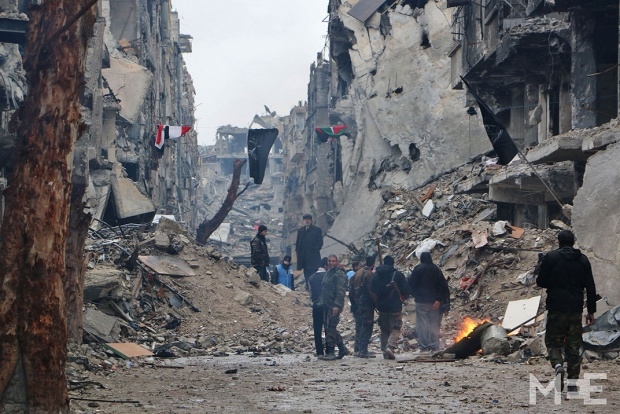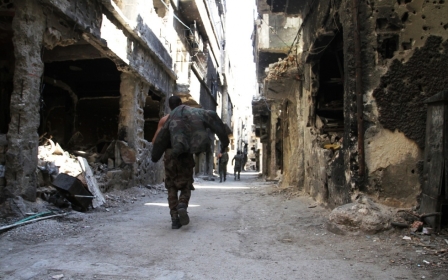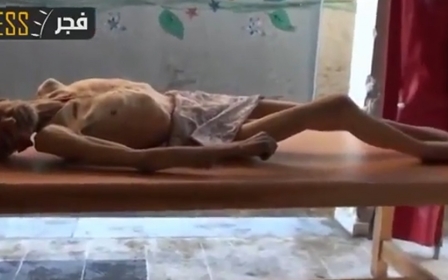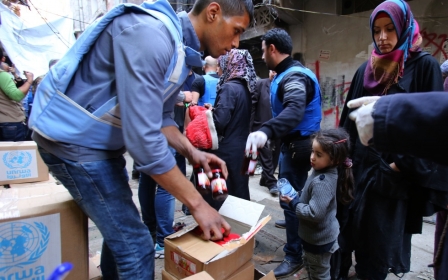UN: Yarmouk no longer classified as besieged despite appalling conditions

As the conflict rages on in Syria, one area that has suffered devastating consequences is now being dealt another blow.
While humanitarian aid has not been delivered to Yarmouk, the largest Palestinian refugee camp in Syria, for four months, the UN has removed the camp from its list of besieged areas in Syria, IRIN News reported on Friday.
Once home to more than 180,000 Palestinians and Syrians alike, Yarmouk has been under attack since December 2012 when Syrian government forces began shelling the camp. Its population has been decimated as tens of thousands have fled to escape barrel bombs, arrests, and a tightening siege.
Only 18,000 people remain in Yarmouk. For more than two and a half years, a Syrian government siege has forced residents to eat animal feed and stray cats, dogs and donkeys in order to survive. Syrian authorities control the checkpoints to the north, preventing anyone from entering or leaving it. The rest of the camp is under disputed control by both opposition and government-allied Palestinian armed groups.
Medical aid, sorely lacking, has been delivered on rare occasions and is never enough, residents have told Middle East Eye. Locals have frequently complained that when humanitarian aid is allowed to pass through, it is always shifted to other neighbouring areas such as Yalda and Babila.
In April, Yarmouk briefly captured worldwide attention after the Islamic State group (IS) entered it. Despite the gun battles that took place between IS and other opposing armed groups, activists told MEE that the largest threat continues to be from President Bashar al-Assad’s barrel bombs that they say are dropped indiscriminately over residential houses, schools, and clinics.
The UN has repeatedly called for the Syrian government to allow access into the camp, condemning the catastrophic conditions. Chris Gunness, the spokesperson for the United Nations Relief and Works Agency has described Yarmouk as a “hellhole”. Aid has not been delivered to the camp for four months now.
“Access to Yarmouk in the context of the last few years has been appalling,” Gunness said. “We have not managed to have the access that we need and certainly we have not been in the camp since 28 March, just a few days before IS moved in.”
While the UN lacks direct access to Yarmouk, it has been able to deliver aid to three neighbouring suburbs, which led UN secretary-general Ban Ki-Moon to reclassify the camp as no longer under siege in a report released in late June, IRIN News reported on Friday.
'Highest concern'
However, IRIN notes, the UN’s own definition of a besieged area is characterised as being “surrounded by armed actors with the sustained effect that humanitarian assistance cannot regularly enter, and civilians, the sick and wounded cannot regularly exist the area.”
UNRWA has no say in reclassifying the camp’s status. Instead, the decision is made by the secretary-general on the advice of the Office for the Coordination of Humanitarian Affairs (OCHA), which supervises UN emergency aid programmes.
Valerie Syzbala, the author of a report published in March by the Syrian American Medical Society Foundation (SAMS), told IRIN that OCHA has not applied its definition of areas under siege on a consistent basis.
The SAMS report recognises 38 communities throughout Syria that should be considered by the UN as besieged.
“OCHA makes concessions to the Syrian government regarding besieged areas that it feels are appropriate to do good work,” Syzbala said. “This means sacrificing the means in order to deliver the ends. But it is not appropriate, and I think they are doing more damage than good.”
Amanda Pitt, the OCHA spokesperson, told IRIN News: “For the time being, Yarmouk is not considered besieged, but it remains an area of highest concern. Thousands of civilians remain trapped in the area, and thousands more have been displaced to the surrounding areas of Yalda, Babila, and Beit Sahm.”
Middle East Eye propose une couverture et une analyse indépendantes et incomparables du Moyen-Orient, de l’Afrique du Nord et d’autres régions du monde. Pour en savoir plus sur la reprise de ce contenu et les frais qui s’appliquent, veuillez remplir ce formulaire [en anglais]. Pour en savoir plus sur MEE, cliquez ici [en anglais].




